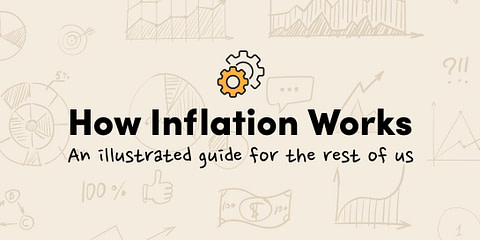When people discuss the national economy, they often use the term Gross Domestic Product or GDP. This is a commonly used measure of the strength of an economy. When it is going up, the economy is getting stronger. When it falls, the economy is moving toward recession. But why is GDP important and how can you calculate it?
We’ll break things down.
What Is GDP?
Gross Domestic Product measures the value of every good and service that an economy produces. While you could calculate GDP for any economy over any period, it’s typically used to measure national production over the course of a year. The higher a country’s GDP, the stronger its economy is because it produces goods and services with higher value.
To put it another way, you can think of GDP as being similar to a score in an arcade game. Higher scores are better, and you don’t want to see a situation where you’re losing points instead of gaining points.
The idea is simple but fully understanding it can be more difficult. Calculating the value of absolutely everything an economy produces is complicated and there are multiple different ways to calculate GDP.
Different Types of GDP
Economists use GDP for many purposes, such as comparing the economy of two different countries or tracking changes in the size of an economy. To help with these comparisons, they’ve come up with multiple types of Gross Domestic Product to track, each with pros and cons and different purposes.
Nominal GDP
Nominal GDP is the simplest type and also one of the most frequently used. It’s simply the value of everything an economy produces without making any adjustments or worrying about things like inflation. That also means that it is the easiest to calculate.
This means it can be used for comparing different economies or measuring output but is less useful for comparisons across time periods.
Real GDP
Real GDP measures Gross Domestic Product with adjustments for inflation.
Inflation is the process through which money loses purchasing power over time. If you’ve ever heard your grandparents talk about buying a loaf of bread for a nickel even though it costs a few dollars today, you’ve heard about the impacts of inflation.
Because of inflation, nominal GDP can rise even if an economy’s true production remains static.
👉 For example: Picture a country that makes $1 million worth of widgets and absolutely nothing else. The next year, that country produces the exact same number of widgets. If inflation is 10%, the country will sell those widgets for $1.1 million. The country’s GDP has risen to $1.1 million due to inflation, even though it produced exactly the same products.
Real GDP adjusts for the impacts of inflation, so the real GDP of that country would be the same in both years. To calculate real GDP, you choose a baseline year and adjust nominal GDPs in the other years measured for inflation compared to the baseline.
To change real GDP, an economy has to actually change its economic output. Changes in its currency value won’t matter. This makes real GDP useful for comparing changes in an economy over time.
Per Capita GDP
GDP per capita accounts for the number of people participating in the economy and looks at how much an economy produces per person.
Consider two countries, each producing $1 trillion worth of goods and services. If one country has a population of 100 million and the other a population of 1 billion, their economies likely look very different despite having the same production. Workers in the smaller country must produce more or higher value goods than workers in the larger country because there are far fewer of them.
👉 For example: India’s GDP is around $3.39 trillion, and Denmark’s is around $395 billion. India’s per capita GDP is around $2,389, while Denmark’s is almost $66,983. India has a much larger economy, but the average Dane is far more productive and enjoys a much higher standard of living.
Per capita GDP is a good measure of a country’s prosperity, if not of its total economic strength.
You can calculate a country’s GDP per capita in either real or nominal terms. All you have to do is divide the GDP by the population.
Purchasing Power Parity
Different products cost different amounts in different places. This is true even within a country, but the effect is very pronounced when you start comparing prices across countries.
Purchasing Power Parity (PPP) is a measurement of the prices of a specific basket of goods and services in different countries. In general, the strong a country’s currency, the higher its PPP will be. Higher PPPs also correlates with a higher standard of living.
GDP PPP is a measure of economic output that adjusts a country’s GDP for factors that influence PPP, including exchange rates and purchasing power. This makes it useful for comparing the economic output of an economy in relation to its cost of living.
How to Calculate GDP
Calculating GDP is complicated, there’s no hiding that fact. It requires figuring out the worth of everything that an economy produces, from the smallest item to the most expensive luxury goods. It also needs to account for the value of services, which can be even harder to track.
There are no perfect solutions for calculating GDP, so economists use a few different methods.
Production
The production approach calculates GDP based on the value of all of the final goods that an economy produces. The formula is:
Gross Value Added – Intermediate Consumption = Value of Output (GDP)
The issue with this method is that it is all but impossible to figure out how much an economy is producing or how much that production is really worth. In many cases, goods and services can go untracked.
👉 For example: If you have a woodworking hobby, you might make some furniture for your home. You’re producing goods that have value. However, if you never sell your homemade furniture, the things you create will never show up in economic calculations even though they should influence GDP.
Similarly, the economic value of housework and childcare provided by stay-at-home parents is not part of GDP.
The production method also ignores the underground economy, which includes goods and services that aren’t reported to the government. This can include the sale of illegal goods and services, bartering, or under-the-table transactions.
Income
Instead of looking at production, the income method of calculating GDP considers all of the money that companies and people in an economy earn. The formula for this method is:
Total National Income + Sales Taxes + Depreciation + Net Foreign Factor Income = GDP
Total National Income is the sum of all wages, rents, interest, and profits.
Net Foreign Factor Income is the difference between the income an economy’s citizens and businesses produce in other countries versus the income produced by foreign citizens and businesses produce in the domestic economy.
The income method can be easier than the production method. One reason for this is that people and companies have to report their income for tax purposes.
While it makes sense that the money people earn in an economy will be roughly equal to the value of the goods and services the economy produces, this method has a few flaws.
One is that production can increase without a commensurate increase in incomes, especially for everyday workers. Another is that it fails to account for people who save and invest money rather than spend it.
Expenditure
The expenditure approach to calculating gross domestic product adds up all of the money spent in an economy to determine the value of the goods it produces.
The theory is that if an economy produces a product, it must get sold to someone. If you just figure out how much money gets spent, you’ll know how much everything produces is worth.
The formula for the expenditure method is:
Consumption + Government Spending + Investment + Net Exports = GDP
Consumption is all private spending on goods, but not on things like real estate or other major investments.
Government spending includes government spending on goods and services as well as wages paid. Things that reallocate money between groups, like unemployment benefits or subsidies are excluded.
Investment includes spending on things like capital equipment, inventory, and housing.
Net exports is the difference between the value of a country’s exports and its imports.
A drawback of the expenditure approach is that it ignores the true value of a product or service and only looks at what was paid. If someone overpays for a product this approach only looks at the money that changed hands rather than what the product was really worth.
Why Does GDP Matter?
GDP matters because it’s one of the best tools that economists have to measure economies. That means that GDP gets used to quantify changes in a nation’s economy over time and to compare different economies.
In general, when a country’s GDP is growing, that is a good thing for its citizens. Modern economies tend to rely on constant growth resulting in continuing employment and wage growth for citizens. It also tends to lead to growth in a country’s investment market.
On the other hand, when GDP falls, it indicates a country is in recession or moving toward recession. Unemployment is likely rising, and people face financial issues. Politicians often respond to falling GDP by taking steps to try to boost the economy, such as reducing interest rates or increasing the money supply.
While GDP is a good rough indicator of economic health, it also has limitations. It does not consider wealth distribution or inequality, which can lower the standard of living of the average citizen even if GDP rises. GDP doesn’t consider environmental damage, sustainability, or the value of non-market transactions.
For those reasons, GDP is primarily a quick rule-of-thumb indicator. It matters, but it has to be considered alongside other factors like the Gini index (for wealth inequality) and the Human Development Index (HDI). We can’t ignore GDP but we also can’t rely on it exclusively!











